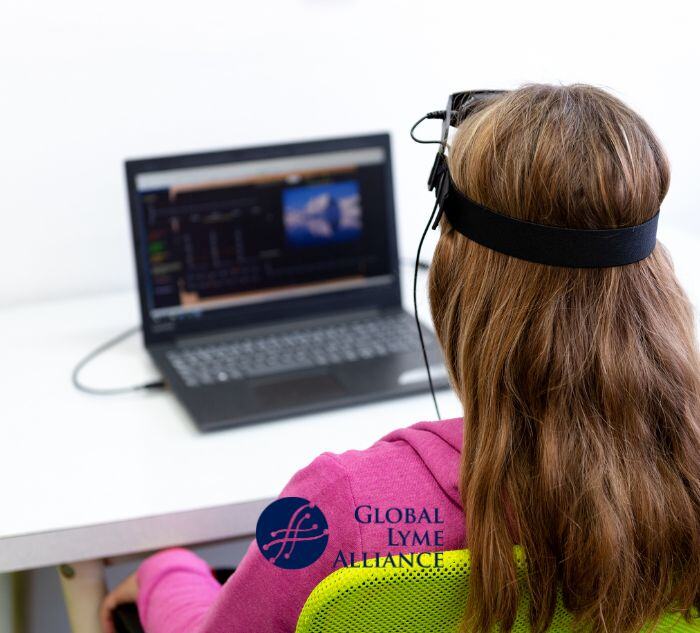
Learn about the benefits of neurofeedback as an adjunct therapy for Lyme disease, how it works, and how to find a practitioner. Find out how neurofeedback can help manage symptoms and improve quality of life.
When I was first diagnosed with Lyme disease, I thought, this will be easy! Lyme is a bacterial infection, so I’ll take a round of antibiotics, and I’ll be good to go. For some Lyme patients, especially those who are diagnosed and treated immediately following a tick bite, this prognosis does turn out to be true. Ten to twenty percent of those patients, though, still go on to experience persistent symptoms. And those of us whose cases took much longer to diagnose, or are complicated by co-infections, likely have a longer journey to wellness.
My own case took eight years to diagnose, and was complicated by the tick-borne diseases babesiosis and ehrlichiosis, as well as by chronic active Epstein-Barr virus. The tick-borne infections had crossed the blood-brain barrier, causing neurological symptoms like brain fog, insomnia, burning extremities, and hallucinogenic nightmares. It took almost a year of intravenous antibiotics to get my infections into remission, and then I suffered a complete relapse before truly learning to manage my chronic illnesses in a way that has kept me in maintenance mode for over a decade.
Because there is no set protocol for treating Lyme disease, everyone requires different medications and therapies that work for their specific case. For me, it’s taken a combination of Western medication and natural treatment as well as adjunct therapies such as integrative manual therapy, physical therapy, talk therapy, and neurofeedback. I’d never heard of neurofeedback before I got sick, but it’s made a big difference in managing my sleep disturbances. Let me explain what neurofeedback is and how it works.
What is Neurofeedback?
Neurofeedback is similar to biofeedback, except it works on the brain instead of the body. Biofeedback uses the body’s own feedback to regulate functions like heart rate and breathing. Neurofeedback uses the brain’s own feedback to regulate the brain so that it works at its best. In essence, neurofeedback allows the brain to retrain itself for peak performance, whether that’s optimal rest, clearer thinking, or less intrusive thoughts. Some creatives feel that neurofeedback helps them find their muse.
How Does Neurofeedback Work?
During a neurofeedback session, you sit in a comfortable chair in front of a TV or computer monitor. A practitioner will place sensors on different points on your scalp and ears. These sensors are connected to a computer that receives feedback from your brain while you watch kaleidoscope-style images on the screen and listen to music. Based on feedback from your own brain, the music will sometimes skip, making a clicking sound. The interruptions are linked to turbulent brain activity, and they signal the brain to self-correct. All you need to do is relax. You don’t even have to watch the screen if you don’t want to; sometimes the images would be too much for my sensory-overloaded brain, so I would simply close my eyes.
Is Neurofeedback Invasive?
No. Neurofeedback is completely non-invasive. It works solely based off your brain’s own feedback. The sensors are attached to your scalp and ears using a sticky substance that comes out with an alcohol pad or shampoo, and they do not hurt; you won’t even feel them. During my first session, my practitioner told me honestly that he couldn’t guarantee that neurofeedback would help my symptoms, but he could tell me that it would not hurt.
How Does Neurofeedback Help Lyme Disease?
No two cases of tick-borne illness are alike, so the way neurofeedback might help one patient could be totally different for another. Because neurofeedback works on the brain, it may help with neurological symptoms of Lyme disease. However, improvement of neurological symptoms can lead to improvement of physical symptoms. For me, neurofeedback helped retrain my brain to rest when it was supposed to. Along with medication, neurofeedback helped me to fall asleep, and it also reduced the severity and impact of my nightmares. Blissfully, it allowed me to finally fall asleep for a nap during the day, when I’d previously just lie there desperately exhausted but unable to sleep. So, in addition to helping my insomnia, neurofeedback also helped my fatigue.
Are There Different Types of Neurofeedback?
Yes. The type of neurofeedback I use is called Neuroptimal, which works on the entire brain at once. My practitioner cautioned me that other types of neurofeedback such as EEG neurofeedback only work on one area of the brain at a time, which could make my symptoms worse. Talk to a practitioner about your specific symptoms to find out which type of neurofeedback would best suit you.
How Often Should You Do Neurofeedback?
When I was acutely ill with tick-borne disease, I did neurofeedback two-to-three times a week. Once my sleep disturbances quieted down, I did sessions once a week, and eventually once a month as part of my maintenance routine. Sessions are usually 20-45 minutes long. I was lucky enough to have my sessions at a sleep center in a hospital, so they were covered by insurance. Sessions done by private practitioners may not be covered, though you can always try submitting the bill to your insurance company for reimbursement.
How Do I Find a Neurofeedback Practitioner?
Always talk to your Lyme Literate Medical Doctor (LLMD) before starting any adjunct therapy. They may be able to recommend a good neurofeedback practitioner, or you can call the sleep center at your local hospital to see if they do neurofeedback. You can also find a trained practitioner in your area through the NeurOptimal site.
***

Jennifer Crystal
Writer
Opinions expressed by contributors are their own. Jennifer Crystal is a writer and educator in Boston. Her work has appeared in local and national publications including Harvard Health Publishing and The Boston Globe. As a GLA columnist for over six years, her work on GLA.org has received mention in publications such as The New Yorker, weatherchannel.com, CQ Researcher, and ProHealth.com. Jennifer is a patient advocate who has dealt with chronic illness, including Lyme and other tick-borne infections. Her memoir, One Tick Stopped the Clock, was published by Legacy Book Press in 2024. Ten percent of proceeds from the book will go to Global Lyme Alliance. Contact her via email below.







-2.jpg)